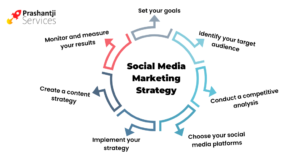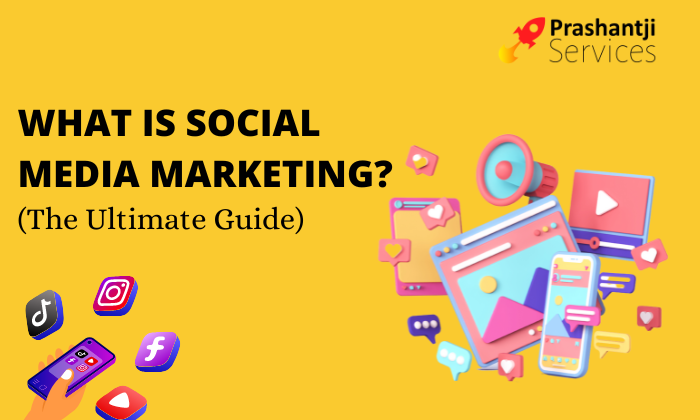What is Social Media Marketing?
Social media marketing is a form of internet marketing that uses social media apps to connect with people and share information. Social media enables brands to build a community around their products, drive traffic to their websites and increase sales.
Creating relevant content that users can share with their own networks helps brands increase their exposure. It also extends their reach toward potential customers, fans, and even potential employees by using the content as a recruitment tool.
Social media marketing allows companies to interact with their audiences in a more personal way, enabling them to get customer feedback while making the organization seem more personable. Social media gives customers a platform to ask questions and voice complaints. It also gives brands the opportunity to respond and adjust business processes or products.
Some of the most popular social media apps include Facebook, Twitter, LinkedIn, and YouTube. Each platform has elements that make it attractive to use–and when a company uses several of them in combination to deliver a multichannel message, consumers can see those messages on their preferred channels.
5 keys to social media marketing
Marketers use social media to deliver their messages, which they can spread through both free and paid means. Social media also enables brands to gain insight into the personal, geographic and demographic information of their audiences, allowing organizations to customize their messaging and content for the best engagement.
Here are five keys of social media marketing that will help you develop a successful program.
1. Social strategy
Marketing campaigns and activities should be planned in advance, with the goal of creating a strategy that is aligned with organizational goals. Organizations need to determine which channels will be used and what types of content will be shared. Examples include:
- Identify your goals.
- Choose the social media platforms that best fit your business’ needs.
- Marketers need to identify the types of content their target audience is likely to engage with on each social platform.
2. Planning and publishing
After you have created a social media strategy, it is time to begin publishing. This can be as simple as posting a new blog post, sharing information about an upcoming event or posting a new product video. But being consistent is the key to an effective SMM program. To build an audience, organizations should post frequently to their page. Consistently publishing relevant content will keep the audience coming back for more.
To make your social media marketing more effective, make sure that the content you post aligns with other marketing promotions. Tools such as Hootsuite, HubSpot and Sprout Social enable you to schedule your posts at the appropriate time.
3. engage with your customers
Businesses that post content on social media platforms can see a boost in interaction and conversations about their brand or products. Users will comment on, tag and share posts, as well as begin communicating through instant messaging functionalities. These types of interactions are ideal because there are notifications in place to alert social media managers so they can practice good customer service which in turn boosts the customer experience.
Social media allows people to discuss a brand, product or service without tagging or speaking directly to a company. Several social media listening tools are available to stay plugged into conversations about your brand, such as Brandwatch, NetBase Quid and Sprinklr. Free tools such as Google Alerts can also notify marketers when their company is being mentioned.
4. Reporting and analytics
As more content is published, it’s important to measure performance. Questions to ask include the following: Where are your followers from? What kinds of posts do they engage with most? What’s working for your brand?
Analytics data collected from each social platform can be compared to a database of all analytics data. This enables marketers to evaluate the overall success and failures of their marketing campaigns.
5. Advertising
The cost of social media marketing is minimal, with the exception of time and specialized tools. A free audience can be built on free sites, then expanded to more expensive options.
Paid marketing features can be very valuable to organizations. They can target their advertisements at audiences based on many factors, including demographic information, retargeting and behaviors. Native advertising on social media lets you reach your audience in a personal way.
Advantages and disadvantages of social media marketing
Social media marketing has become an essential part of the overall marketing strategy for many businesses today. While it offers many advantages, it also has some disadvantages that businesses should be aware of. Here are the advantages and disadvantages of social media marketing:
Advantages:
- Increased brand awareness: Social media platforms have millions of active users, and businesses can leverage this audience to increase their brand’s visibility.
- Improved customer engagement: Social media allows businesses to interact with customers and build relationships by responding to their inquiries, comments, and feedback.
- Cost-effective: Social media marketing can be cost-effective compared to other marketing channels like TV, radio, or print ads, making it accessible to businesses of all sizes.
- Targeted advertising: Social media platforms allow businesses to target specific audiences based on demographics, interests, and behaviors, resulting in more effective and efficient advertising campaigns.
- Increased website traffic: Social media can be used to drive traffic to a business’s website, resulting in increased leads and sales.
Disadvantages:
- Time-consuming: Creating and managing social media content and engaging with customers can be time-consuming, especially for small businesses with limited resources.
- Negative feedback: Social media can expose businesses to negative feedback from customers, which can harm their reputation if not managed effectively.
- Short attention span: Social media users have a short attention span, and it can be challenging to capture their attention with content that stands out from the competition.
- Platform changes: Social media platforms are constantly evolving, and businesses need to keep up with these changes to ensure their marketing efforts remain effective.
- Dependency on third-party platforms: Social media marketing is dependent on third-party platforms, and businesses have limited control over the algorithms and policies that govern these platforms.
Social media marketing offers many benefits for businesses, but it also comes with its own set of challenges. To succeed in social media marketing, businesses need to develop a well-planned strategy, understand their audience, create engaging content, and stay up-to-date with the latest trends and best practices.
How to Develop a Social Media Marketing Strategy

Creating a social media marketing strategy requires careful planning and execution. Here are the steps you can follow to develop a successful social media marketing strategy:
- Set your goals: The first step in creating an SMM strategy is to define your goals. What do you want to achieve through social media? Is it increasing brand awareness, generating leads, driving sales, or improving customer engagement? Once you have a clear understanding of your objectives, you can tailor your strategy accordingly.
- Identify your target audience: Your social media strategy should be tailored to your target audience. Determine who your audience is and which social media platforms they use. This will help you create relevant content that resonates with them and improve the effectiveness of your campaigns.
- Conduct a competitive analysis: Research your competitors’ social media presence to understand their strengths and weaknesses. Analyze their content, engagement rates, and follower count to gain insights into what works and what doesn’t.
- Choose your social media platforms: Based on your target audience and competition analysis, choose the social media platforms that are most relevant to your business. It’s important to focus on platforms that are aligned with your goals and where your audience is most active.
- Create a content strategy: Develop a content strategy that aligns with your goals, target audience, and social media platforms. Your content should be engaging, informative, and relevant to your audience. You can use a mix of formats, including images, videos, infographics, and blog posts.
- Implement your strategy: Once you have a plan in place, it’s time to start implementing your strategy. Consistency is key, so make sure you’re posting regularly and engaging with your audience.
- Monitor and measure your results: Track your social media metrics to measure the success of your strategy. Analyze your engagement rates, follower growth, website traffic, and leads/sales generated through social media. Use this data to refine your strategy and improve your results.
A well-planned social media marketing strategy can help businesses achieve their marketing objectives, engage with their audience, and grow their brand. By following these steps, you can develop a successful social media marketing strategy that drives results.
In conclusion, social media marketing is a crucial component of modern-day business. With billions of users active on social media, it presents an incredible opportunity for businesses to connect with their target audience, increase brand awareness, and drive sales. By following the steps outlined in this ultimate guide, businesses can create a well-planned social media marketing strategy that aligns with their goals, target audience, and platforms. Ultimately, social media marketing can help businesses grow and achieve their marketing objectives.








